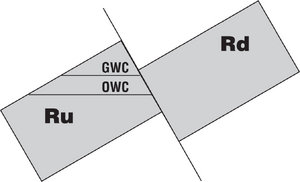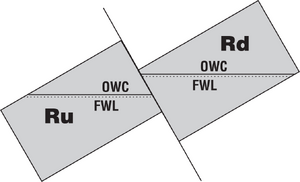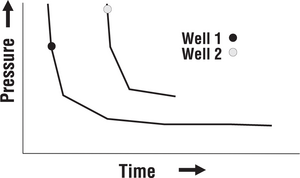Cross-sealing fault
| Exploring for Oil and Gas Traps | |

| |
| Series | Treatise in Petroleum Geology |
|---|---|
| Part | Predicting the occurrence of oil and gas traps |
| Chapter | Evaluating top and fault seal |
| Author | Grant M. Skerlec |
| Link | Web page |
| Store | AAPG Store |
A cross-sealing fault prevents communication of hydrocarbons between juxtaposed sands (reservoirs). Cross-sealing faults can be identified using the following criteria:
- Hydrocarbon-bearing sands against water-wet sands
- Different hydrocarbon contacts
- Different pressures
Hydrocarbon against water
A fault is cross sealing if it juxtaposes hydrocarbon-bearing sands with water-wet sands, as illustrated in the following figure. Both oil and gas are prevented from flowing into the sand in the hanging wall (Rd) by the cross-sealing fault.
Different hydrocarbon contacts
A fault is also cross sealing if it juxtaposes sands with different hydrocarbon contacts and/or different free water levels, as illustrated in the following figure. Small differences in hydrocarbon contacts do not necessarily imply a cross-sealing fault because the capillary properties of the juxtaposed sands can create different hydrocarbon contacts even across a cross-leaking fault. Different free water levels do imply a cross-sealing fault.
Different pressures
Different pressures across a fault imply cross seal. In the figure below, wells 1 and 2 are separated by a cross-sealing fault. Well 2 encountered virgin pressures in contrast to the lower pressures in the main field.
See also
- Fault seal behavior
- Cross-leaking faults
- Dip-sealing faults
- Dip-leaking faults
- Controls on percent fill


